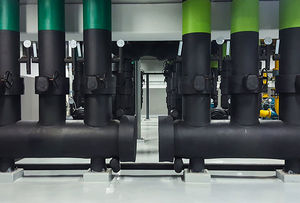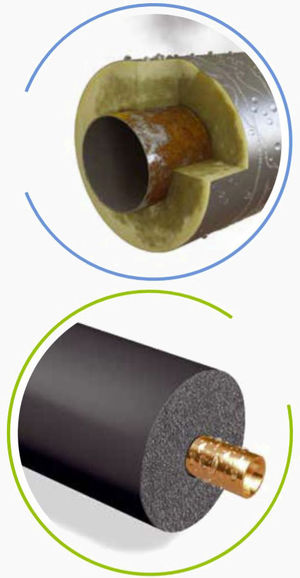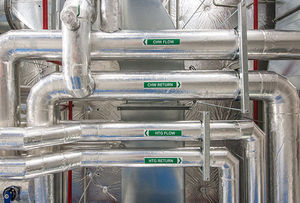 The emissivity of the surface of insulation or its jacketing can affect the thickness required to insulate cold piping. With the exception of flexible elastomeric foam, practically every insulation used on cold systems, from chilled water lines, to refrigerant piping, to cryogenics, is installed with some sort of vapor retarder or jacketing. The vapor retarder and jacketing materials are often low emissivity compared to the insulation, but they are required to prevent moisture ingress and corrosion. High emissivity materials like flexible elastomeric have a natural advantage when it comes to preventing condensation.
The emissivity of the surface of insulation or its jacketing can affect the thickness required to insulate cold piping. With the exception of flexible elastomeric foam, practically every insulation used on cold systems, from chilled water lines, to refrigerant piping, to cryogenics, is installed with some sort of vapor retarder or jacketing. The vapor retarder and jacketing materials are often low emissivity compared to the insulation, but they are required to prevent moisture ingress and corrosion. High emissivity materials like flexible elastomeric have a natural advantage when it comes to preventing condensation. Condensation is formed when a surface temperature is at or below dew point, and the moisture in the air condenses and forms liquid water. For example, in an environment that is 80° F with 75 percent relative humidity, the dew point is 72° F. Water will condense on any surface at or below 72 F. Once condensed moisture gets in, the insulation system is compromised as water is much more conductive than insulation. This process is referred to as moisture ingress. For insulation products that absorb moisture, or that are installed in several small pieces with multiple paths for moisture, a vapor retarded insulation or jacket is absolutely required.
Condensation is formed when a surface temperature is at or below dew point, and the moisture in the air condenses and forms liquid water. For example, in an environment that is 80° F with 75 percent relative humidity, the dew point is 72° F. Water will condense on any surface at or below 72 F. Once condensed moisture gets in, the insulation system is compromised as water is much more conductive than insulation. This process is referred to as moisture ingress. For insulation products that absorb moisture, or that are installed in several small pieces with multiple paths for moisture, a vapor retarded insulation or jacket is absolutely required.
Just about the only type of insulation not requiring a vapor retarder or jacket in these applications is flexible elastomeric because flexible elastomeric has both a naturally low water vapor permeability and moisture absorption, and because it is installed in long, continuous sections for most cases. Many of the vapor retarder and jacketing products use low emissivity materials, like aluminum, stainless steel, and light-colored polymeric films, while the insulation materials themselves, including flexible elastomeric, are high emissivity. Emissivity is the amount of radiant heat absorbed by a surface. Surface emissivity directly affects the temperature of a surface because the emissivity determines how much of the radiant heat has been reflected or absorbed. A high emissivity black surface absorbs radiant heat and a white surface is reflecting it off. Aluminum has an emissivity of about 0.05, meaning it absorbs just about 5% of the radiant heat, reflecting away the remaining 95%. Stainless steel has an emissivity of about 0.15 and reflects away about 85%. On the other hand, a black flexible elastomeric insulation, like ArmaFlex®, has an emissivity of 0.93, meaning that it absorbs 93% of the radiant heat, keeping the surface hotter longer. In some cases, the insulation may need to increase in thickness to prevent condensation when a low emissivity surface is used. Take a look at the following table below where the thermal conductivity of the insulation is held constant, and the insulation thicknesses required to prevent condensation are shown depending on the environment.
Aluminum has an emissivity of about 0.05, meaning it absorbs just about 5% of the radiant heat, reflecting away the remaining 95%. Stainless steel has an emissivity of about 0.15 and reflects away about 85%. On the other hand, a black flexible elastomeric insulation, like ArmaFlex®, has an emissivity of 0.93, meaning that it absorbs 93% of the radiant heat, keeping the surface hotter longer. In some cases, the insulation may need to increase in thickness to prevent condensation when a low emissivity surface is used. Take a look at the following table below where the thermal conductivity of the insulation is held constant, and the insulation thicknesses required to prevent condensation are shown depending on the environment.

At 70% relative humidity, the difference is smaller, with less than 1/2 inch of insulation needed with flexible elastomeric, but 3/4 inch of insulation is needed if a stainless steel jacket is used, and nearly a full inch of insulation if an aluminum jacket is used. At 90% relative humidity though, the differences are much more pronounced, with exposed flexible elastomeric insulation only requiring 2 inches to prevent condensation, but insulation jacketed with stainless steel requiring over 4-1/2 inches, and insulation jacketed in aluminum requiring nearly 6 inches.
All things being equal, the higher emissivity surface of flexible elastomeric insulation like ArmaFlex, will simply do a better job of preventing condensation compared other insulation products with a low emissivity vapor retarder or jacketing.
Download the Surface Emissivity white paper here.
November 10, 2021
